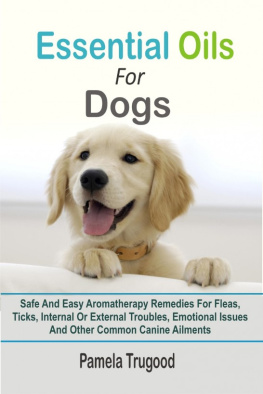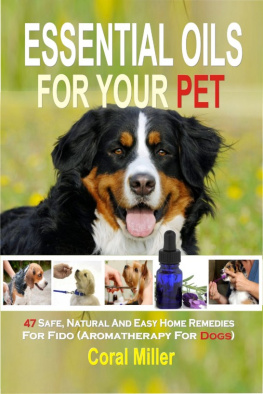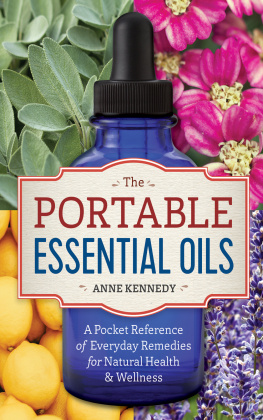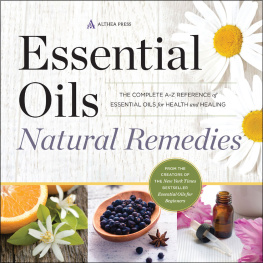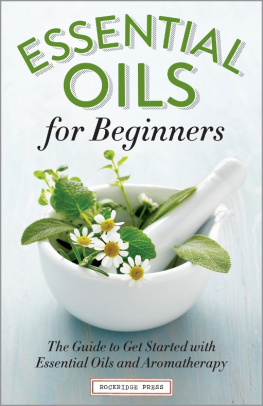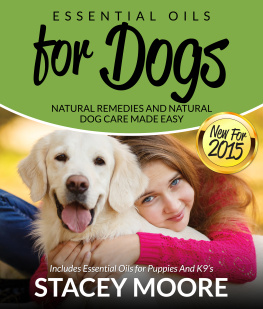Essential Oils For Dogs
Safe And Easy Aromatherapy Remedies For Fleas,Ticks, Internal Or External Troubles, Emotional Issues And OtherCommon Canine Ailments
Pamela Trugood
Copyright 2015 by Pamela Trugood All rights reserved. No part of thispublication may be reproduced, distributed, or transmitted in anyform or by any means, including photocopying, recording, or otherelectronic or mechanical methods, without the prior writtenpermission of the publisher, except in the case of brief quotationsembodied in critical reviews and certain other noncommercial usespermitted by copyright law. Published by Winsome X Publishing atSmashwords 2015 Table of Contents INTRODUCTION The use of aromatherapy for humans is well- known and wide spread.Lately, it has been discovered that essential oils are beneficialfor dogs, too. That is very logical as the sense of smell is farmore powerful in dogs than in humans. As a result, aromatherapy became a lesscostly alternative to conventional pharmaceutical treatments forsome dog ailments. It is used as an option for many healthproblems: skin irritation, ear and nose care, pains due to agingand arthritis, internal problems like vomiting, diarrhea,parasites, anxiety and stress.
Also, there are many essential oilsproducts that can keep away ticks, fleas and other insects. Theycan be used to eliminate bad odors and for general pets'hygiene. So, What Are Essential Oils? Essential oils are natural extracted essencesfrom real plants. They are extracted (usually by distillation) fromthe leaves, barks, flowers, roots and seeds of aromatic plants,herbs or shrubs. They are highly concentrated with a powerfulfragrant. The term essential oil could be confusing becauseessential oils arent actually oils but volatile extracts thatevaporate at room temperature.
Essential oils have antiviral, antimicrobial, antibacterial, anti-fungal, anti inflammatory anddetoxifying effects. They have anti-toxic and anti venom effects aswell. They are also calming, stimulating or sedative, depending onthe therapeutic properties of the plant. When using essential oils in dogs (and inhumans too), you must be very careful with their quality. Youshould purchase only therapeutic grade oils that are pure and donot contain any others additives. This is quite important becauseessential oils are very powerful and adulterated oil may do yourdog more harm than good.
Their healing capacity may be altered bythe added chemical substances. A quick way to check whether an extract ispure and distilled is by conducting the following test: place adrop of extract on a plain paper. If you notice oil traces afterone or two days, then the oil is adulterated but if it evaporates,the oil is pure. The fact that essential oils are far morepowerful than their plant components demand that a safety guide isfollowed when they are being used on dogs. It is best to consult avet if you want to apply long term treatment on your furry friend.Used in large quantities, essential oils can become toxic and harmyour beloved dog. It is better to apply sparingly.
Some Safety Guidelines To Consider * Always purchase pure, therapeutic gradeoils. * Do not use undiluted oils when applyingdirectly to the skin. Some essential oils can lead to severeadverse effects such as burns, skin irritation or photo sensitivity(examples are some citrus oils). However, a few oils such as lavender may beused undiluted. Lavender heals burns successfully. It is best totest the dog's skin first as he may find lavender essential oilirritating as well.
If that is so, dilute the oil first. * Consider the size of the dog: use a smallerquantity on smaller dogs. * Pay attention to the dog's health: if he issick, treat him with less essential oil. This is also applicablefor puppies and old dogs. * Consider pregnant dogs. * Do not use Rosemary on epileptic orseizure- prone dogs. * Avoid the following areas when usingessential oils: eyes, nose, anal and genital area. * Treatment must not exceed two weeks toenable your pet rest for a while. * Treatment must not exceed two weeks toenable your pet rest for a while.
How To Use Essential Oils On Dogs Direct application onthe affected area is the most effective way. This means theessential oil is diluted and applied to the skin. This method isvery effective because the essential oils are quickly absorbedthrough the capillaries. They can be applied in multiple ways, suchas via massage, sprays or added to products such as shampoos, balmsand salves. Another way is to use classical aromatherapy products such as diffusers orinhalers. The dog must stay in the same room with the diffuser forat least 30 minutes, twice/day so the treatment could be effective.You may also use a humidifying device in the place where the dogsleeps.
The essential oils may be used internally as well, but consulting a veterinarianbeforehand is highly recommended. Essential oils are powerful soletting your dog consume any kind of oil without prior consultationcould harm it. The vet will let you know what essential oil and thequantity that your dog can safely ingest. Some Essential Oils Considered Safe For DogsInclude: Lavender this is one of the few oilsthat can be used undiluted. It is useful in treating anxiety,burns, motion sickness and it has a calming, sedative effect Fennel helps with the pineal glandsand thyroid and it has a detoxifying effect. Frankincense very effective inboosting the immune system.
It is also used for reducingtumors. Cardamom very good for a normalappetite, also diuretic and effective in colic. It is used forcoughs and nausea as well. Helichrysum effective in open woundsto reduce the blood flow and it is also anti-bacterial. It hasproven to have beneficial effects in cardiac health problems. Peppermint is used for internalconditions such as diarrhea, colic, and nausea.
Good for weightloss and metabolism. For dilution you should use any carrier oil:almond, olive, sunflower, jojoba, coconut, etc. The standarddilution would be 10-15 drops essential oils to oz carrieroil. On the other hand, you should takecaution when using the following essential oils: Anise (or Hissop, White Thyme,Camphor, Yarrow) pregnant dogs can be affected by these oilsas they are uterine stimulator. Mustard or Tansy may cause severeskin irritation Wintergreen or Birch studies haveproved that these two oils are toxic for topical use. Wormwood another essential oilthought to be very toxic. Wormwood another essential oilthought to be very toxic.
It may cause seizures and renal collapsein humans. Pennyroyal this essential oil iscommonly used for its repellent effect. But it is also toxic forthe nervous system and the kidneys. There have been cases ofabortion reported in animals when using this essence. Rue one of the oils with the mostpowerful photosensitive effect. Always avoid the use of essential oils thatmay be unsafe to you and your pet.
Ask a veterinarian whether youmay use or not a certain essential oil. It is better not to conductexperiments on your furry friend. You may hurt him although you aretrying to cure him. Only use the safe essences and, as werecommended before, avoid internal administration. Essential oils have tremendous benefits andif you follow the safety guidelines, your dog will be happy andhealthy. ANXIETY Essential Oils Blend for Anxiety Use this blend if your doghas noise or separation anxiety.
It also works for pet with fearsof new people or places. Ingredients 1/2 oz base oil (jojoba, olive oil) 5 drops Lavender 3 drops Valerian 3 drops Sweet Marjoram 2 drops Clary Sage Directions 1 Combine all the ingredients and mixwell. 2 Apply 3 drops of this blend between itstoes, under armpits or on the ears' edge. Calming Lavender Powder This powder is very effective forstressed dogs.

